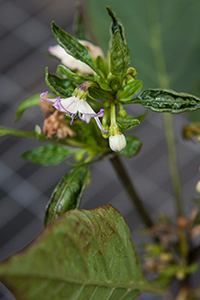
Pepper plant possibly infected with chili thrips. Tyler Jones, UF/IFAS.
Aphids, Mites, and Thrips
Aphids, mites, and thrips are common spring garden pests. They multiply rapidly, meaning that you'll rarely find just one aphid, mite, or thrips. Below are some strategies for identifying and controlling these pests before they take over your garden.
As always, UF/IFAS and the Florida Master Gardener Volunteer Program recommend integrated pest management (IPM), a comprehensive approach to managing plant pests. This approach uses many different methods to manage the landscape as a whole, while minimizing harm to people, property, and the environment.
Aphids
Aphids are small, soft-bodied insects that use their piercing-sucking mouthparts to feed on the sap of living plants. There are thousands of species of aphids and, though many are green, they can come in a variety of colors. Aphids are round to pear-shaped and generally about 1/16th to 1/8th of an inch long (2-4mm).
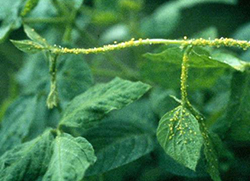
Aphids along a plant's new growth. UF/IFAS
Identifying aphids — You'll find aphids on the tender new growth of garden plants, especially during the first spring flush of growth. Check under the leaves and around new buds. Aphid damage appears as twisted, curling leaves on the newest growth. Sooty mold, a black, dusty-looking fungus that grows on the "honeydew" aphids excrete, is another tell-tale sign of an aphid problem.
Mites
Mites are tiny home and garden pests with two body segments and sucking mouthparts. Adults have four pairs of legs, making them arachnids (relatives of spiders). They are very small, almost microscopic, so gardeners generally recognize them by their damage or webbing rather than their physical presence.
Identifying mites — In the garden, look for stippling (patches of small, light-colored specks) on the tops of leaves. Eventually the leaves will yellow, die, and fall off as the mites continue feeding. Delicate, light webbing under and around foliage is a sign of a common family of mites: spider mites. If you suspect mites, pick a few leaves, tap them over a piece of white paper, and check for mites with a magnifying lens.
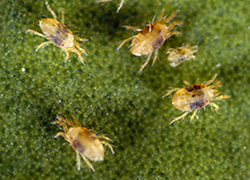
Two-spotted mites, a major pest on more than 200 species of plants. UF/IFAS
Thrips
Thrips are small, winged insects with rasping-sucking mouthparts. They are generally less than 1/8th of an inch long. Their bodies are elongated, more like a grain of rice than the rounded shape of aphids and mites. Thrips can be yellow, brown, or black. Chilli thrips, a particularly problematic species, are light in color, with feathery wings and a dark stripe along their thorax.
Identifying thrips — Look for thrips feeding on young leaves, buds, flowers, and even small fruit. Leaves infested with thrips dry out and have a scarred or silver-flecked appearance. You may see small brownish specks of excrement on the undersides of leaves. Infested flower buds fail to open, or the blooms are deformed. Damaged flowers become streaked and discolored. You can check for thrips as you would for mites, by shaking injured parts of the plants over a white piece of paper.
Chilli thrips feed on dozens of plants, including roses, citrus, plumbago, and Indian hawthorne. They attack all above-ground growth, but prefer young leaves, buds, and fruits. Common symptoms include bronzed, curled, or stunted leaves. Infested plants decline over time, and severe infestations can cause total leaf loss.
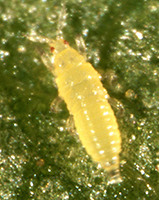
Chilli thrips specimen. Photo provided by Lance Osborne and Jianjun Chen.
Integrated Pest Management
Effective IPM begins with proper plant selection and maintenance. This is followed by regular scouting and monitoring to see if an insect or mite is actually present and causing damage. Once you identify a pest consider cultural, biological, and mechanical controls. Chemical controls are only one weapon in the arsenal of IPM practices, and they should be used only after a number of other tactics have been tried.
Culturally controlling pests means choosing gardening practices that make your plants less vulnerable to pests. This is the most important component of IPM. Aphids, mites, and thrips all feed by sucking the sap out of a plant's tissues. If your plant is underwatered or overfertilized, the nutrients in these juices will be more concentrated and the plant will be more nutritious to pests.
The presence of aphids can be a sign that a plant is well nourished, sometimes too well nourished. Mites are generally found on stressed, dry plants. Thrips are attracted to plants in both conditions. In Florida's dry season some light irrigation may be necessary in even the most drought-tolerant landscapes. Water as needed, and back off on the fertilizer during dry spells, and you'll see fewer pests in the future.
Weeding is another form of cultural control. Controlling the weeds in your garden can remove alternate host plants for many of these pests. Your plants will have less competition for water, too, and additional airflow can help prevent fungal growth.
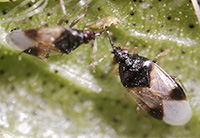
Insidious flower bugs are a key predator of western flower thrips, a major economic pest. UF/IFAS
Biological control simply means allowing a pest's natural predators to thrive in your landscape and help you control the pests. Think of your garden as an ecosystem, one with both predators and prey. Lady beetles, mantises, spiders, wasps, lacewings, and other beneficial insects all enjoy a meal of aphids, mites, and thrips. If you avoid broad-spectrum insecticides, or use them only for severe pest outbreaks, these predators will survive and keep the pests in check in your garden.
It's worth mentioning that some mites and thrips are predatory. Before you spray, look for damage. If a plant looks healthy and happy, the insect or arachnid in question might be a "good bug."
Mechanical controls are actions, like pruning, that physically remove a plant or pest from the landscape. If you prune away an infested or diseased portion of a plant, be sure to keep it separated from the rest of your landscape plants. Piles of decaying plant material can harbor the pests you hoped to remove.
For small, soft-bodied pests like the ones discusses here, one very effective mechanical control is a strong blast of water from the hose. Aphids and thrips are sent flying and the plant often has time to recover and harden before they can make their way back to the new growth.
Chemical controls are an important, but final step in an IPM approach to pest control. Remember, broad-spectrum insecticides kill beneficial insects along with the pests. IPM recommends beginning with the least toxic products, like horticultural oils and insecticidal soaps, applied directly to the pests. And if you're tempted to mix your own, check out our article "Soaps, Detergents, and Pest Management" before you begin.
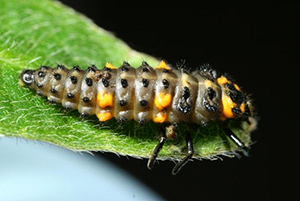
This insect may look like a "bad bug" but it's actually the larval stage of a lady beetle. Identifying insects can help you keep the beneficials alive and well in your garden. Credit: Winston Beck, Iowa State University, Bugwood.org
Always read and follow the insecticide label, and keep in mind that you may need to reapply. As with any pest, make sure you know what's damaging your plants before beginning treatment. For help identifying and managing pests, please feel free to contact us at your county Extension office or the UF/IFAS Pesticide Information Office.

